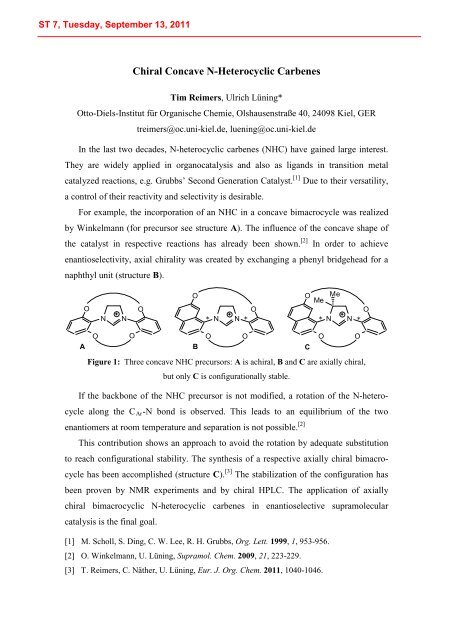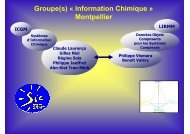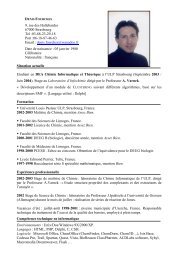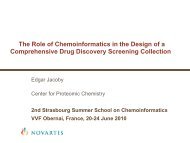International Summer School PROGRAM - Laboratoire d'Infochimie ...
International Summer School PROGRAM - Laboratoire d'Infochimie ...
International Summer School PROGRAM - Laboratoire d'Infochimie ...
You also want an ePaper? Increase the reach of your titles
YUMPU automatically turns print PDFs into web optimized ePapers that Google loves.
Chiral Concave N-Heterocyclic Carbenes<br />
Tim Reimers, Ulrich Lüning*<br />
Otto-Diels-Institut für Organische Chemie, Olshausenstraße 40, 24098 Kiel, GER<br />
treimers@oc.uni-kiel.de, luening@oc.uni-kiel.de<br />
In the last two decades, N-heterocyclic carbenes (NHC) have gained large interest.<br />
They are widely applied in organocatalysis and also as ligands in transition metal<br />
catalyzed reactions, e.g. Grubbs’ Second Generation Catalyst. [1]<br />
Due to their versatility,<br />
a control of their reactivity and selectivity is desirable.<br />
For example, the incorporation of an NHC in a concave bimacrocycle was realized<br />
by Winkelmann (for precursor see structure A). The influence of the concave shape of<br />
[2]<br />
the catalyst in respective reactions has already been shown. In order to achieve<br />
enantioselectivity, axial chirality was created by exchanging a phenyl bridgehead for a<br />
naphthyl unit (structure B).<br />
O<br />
N<br />
N<br />
O<br />
O O<br />
Me<br />
Me<br />
O<br />
O<br />
* N N * * N N *<br />
O O<br />
O O<br />
A B C<br />
O O<br />
Figure 1: Three concave NHC precursors: A is achiral, B and C are axially chiral,<br />
but only C is configurationally stable.<br />
If the backbone of the NHC precursor is not modified, a rotation of the N-heterocycle<br />
along the CAr-N bond is observed. This leads to an equilibrium of the two<br />
enantiomers at room temperature and separation is not possible.<br />
This contribution shows an approach to avoid the rotation by adequate substitution<br />
to reach configurational stability. The synthesis of a respective axially chiral bimacro-<br />
[3]<br />
cycle has been accomplished (structure C). The stabilization of the configuration has<br />
been proven by NMR experiments and by chiral HPLC. The application of axially<br />
chiral bimacrocyclic N-heterocyclic carbenes in enantioselective supramolecular<br />
catalysis is the final goal.<br />
[1] M. Scholl, S. Ding, C. W. Lee, R. H. Grubbs, Org. Lett. 1999, 1, 953-956.<br />
[2] O. Winkelmann, U. Lüning, Supramol. Chem. 2009, 21, 223-229.<br />
[3] T. Reimers, C. Näther, U. Lüning, Eur. J. Org. Chem. 2011, 1040-1046.<br />
[2]









